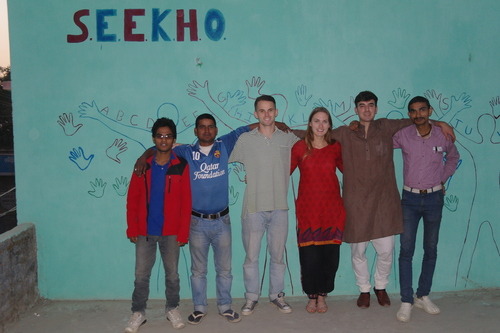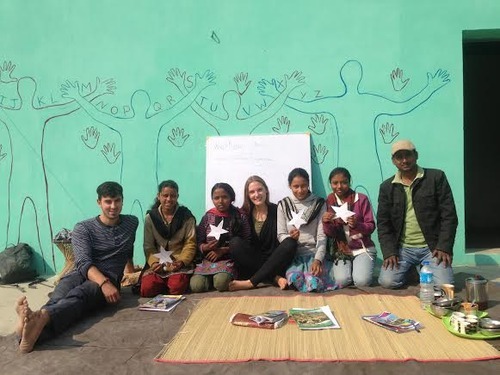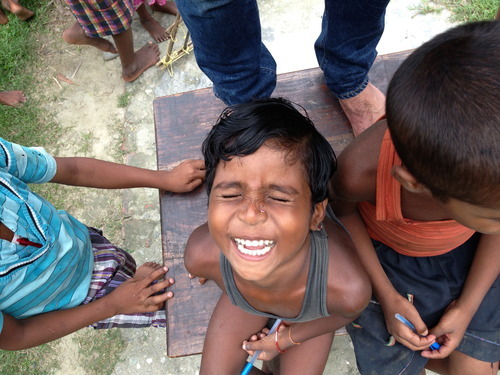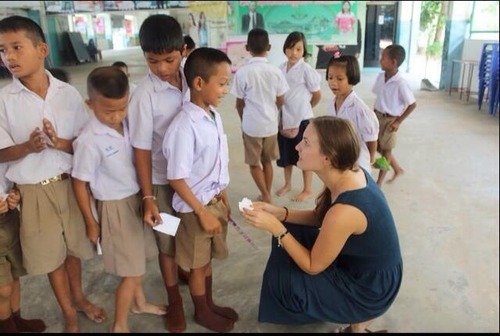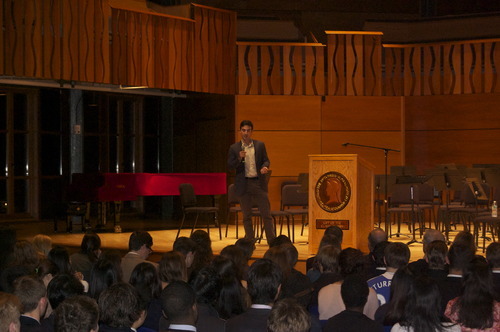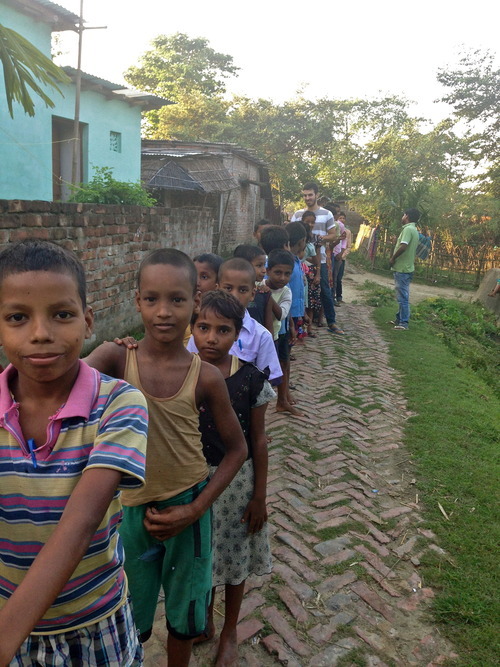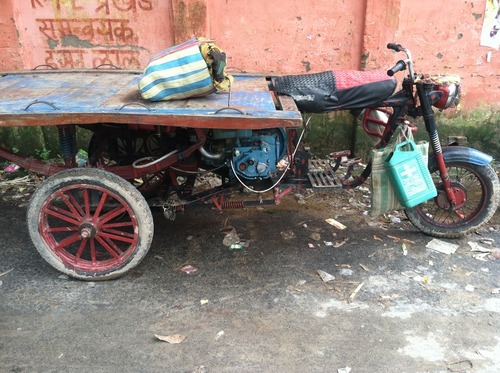My name is Sam Brundrett and I have been working with SEEKHO, in Bihar, since December. This article is on the importance of education and my experience with the organization thus far.
SEEKHO’s “on the ground team” at our main facility.
If you were to conduct a survey of randomly selected people in the United States and ask them if they thought education was important, there would undoubtedly be little variance in their responses. They would reply quickly and resoundingly, “YES”. But if you were to follow up with the question “what type of education is valuable?” you would receive polarizing responses representing the two following educational philosophies: the vast majority valuing an education founded on teaching hard skills and then a passionate minority who value an education that emphasizes teaching soft, non-cognitive, skills. Does this imbalance effectively represent the importance of the two types of skills? Is an education that emphasizes traditional hard skills, such as engineering, math, and computer skills, better than one that focuses on developing the historically misunderstood non-cognitive, soft skills like creativity, curiosity, confidence, to name a few?
The point of this hypothetical survey is not to pit one philosophy against the other. Rather, the point is to illustrate the disproportional and at times rigid dichotomy plaguing our current education system. To ask you to reflect on what aspect of your own education you value most and why that may be. It is easy to understand, from a historical perspective, why soft skills have taken a back seat to hard skills. The areas that are easily measurable and which are backed by years of data are the easiest to focus on and the first to be implemented. Tangible skills appeal to governments, schools, and students alike because of their obvious and almost immediate effect. Yet, in the rush to obtain statistics, the student actually gets left behind. The student’s success is measured by grades and exams and it is assumed that this measure of academic success means they are equipped to overcome all of life’s obstacles. However, this is not the case. Fortunately though, there is a growing paradigm shift in education towards understanding and focusing on those non-cognitive skills that were once thought to be impossible to measure and therefore teach.
In recent years, countries such as Australia and the United States have begun to pioneer this paradigm shift. They are slowly becoming places where the importance of teaching soft skills is no longer dependent on passionate anecdotes and gritty success stories. Through years of research, we have finally begun to understand the importance of soft skills and have, at least in part, figured out methods in which to foster them. Schools like the Geelong Grammar School in Australia and KIPP Charter Schools in the U.S. were among the first to champion a soft skills based curriculum but they are not alone — today many other educational institutions are engaging in the same paradigm shift, resulting in a growing number of students that understand and embody concepts such as curiosity and resilience. Educators at schools like Geelong Grammar and KIPP schools have begun to realize that hard and soft skills do not work in isolation rather; the two sets of skills are complementary. In fact, studies have found that students, who are taught soft skills, consistently outperform their peers, who have not learned such skills, on traditional academic work. However, these institutions still remain the minority and in many impoverished communities around the world, the problem persists.
Personally, the importance of soft skills never seemed so obvious than when I came to India, in December 2013. For the next year I will be working with the educational Non-Profit, SEEKHO, located in the drastically underserved town of Bishanpur, Bihar, India. For years, Bihar has exhibited some of the lowest national percentages in literacy rates and human development and while these statistics are revealing they only paint half of the picture. SEEKHO is an organization born out of a community’s need to combat the psychological oppression and violence that their children were facing in school. Its’ mission is to provide positive support at all stages in a child’s development by focusing on essential skills such as literacy and numeracy as well as how to increase psychological well-being. SEEKHO incorporates a contextualized well-being curriculum, developed by PHD students from UPENN, designed to empower students with the confidence to take advantage of the services within their community. (i.e. hard skills being taught in schools or seeking help from one of the 3.3 million NGO’s in India)
The problem, in India, is by no means the lack of schools (there is a school within 1 kilometer of every child in the nation), but instead it is the quality of the schools. The problem stems from teachers that serve only to reinforce social structures, such as the caste system, and an ineffective educational system that cares only about the student long enough to mark their attendance, teach them that 1+1=2, and how to write their name. (Basically the criteria for being literate or numerate in the particular region I am in.)
As a result, children within this community experience an incredible amount of social discrimination, ultimately influencing how they view their own abilities. We have found time and time again that students do not come to school because they do not think they are capable of learning. When we ask children if they want to learn to write their name, bystanders and frequently their own teachers, those responsible for teaching them, respond unemotionally with, “Don’t waste your time, they won’t be able to”. This psychological abuse is then reinforced as they begin attending school. Children that are born into lower castes are assumed to be “unteachable”. Even those that have had the good fortune to be born into a somewhat higher caste are taught by apathetic teachers, in the off chance the teacher shows up, that enforce rote learning with yes or no, right or wrong answers. While in the classroom, students are discouraged from asking question, often being beaten with a bamboo rod for wrong answers or “acting out”. The school system has one objective: yearly input improvements such as the number of facilities or attendance rates. Unfortunately, this has resulted in incredibly pervasive corruption in the form of bribery and statistical inflation: effectively eliminating the potential for aid to reach the necessary children. Assuming that soft skills will either be taught at home, where in many underserved communities the parents are not as present in their children’s education, or that focusing on them is a waste of time, is naïve. Instead, it is more important than ever that we as educators address the psychological barriers that prevent children from learning and develop programs that effectively foster non-cognitive skills in our students.
My role within the organization is to teach English, analyze program impact, and manage the organization’s finances. I teach English to two groups of students, ages 10-17, whose English abilities range from nothing to basic sentences. As a teacher, I adapt curriculum provided to us by third party educational institutions as well as develop my own. Even before beginning to analyze the impact of our programs and from my first few days in Bishanpur, the absence of soft skills in many of my students has been alarming. They not only lack the confidence to express themselves, or the resilience to try again after failing, they lack a sense of curiosity, which I had previously believed to be innate. I am now in the process of identifying ways of removing their fear of punishment, embarrassment, or shame that they feel while in the classroom. As a result, for the past few weeks, I have been trying to integrate activities that focus on developing skills such confidence, creativity, and critical thinking all the while reflecting, with new found appreciation, on how the schools I attended were always able to find interactive and engaging ways to cultivate soft skills in their students. To date, my attempts at integration have been met with relentless resistance. However, it has been this resistance that has allowed me to gain real insight into the problem. What’s more, the progress that my students do make, however small, elicits that much more excitement and seems that much more significant and lasting.
Living in this community, I have begun to realize exactly how much of my own education I had taken for granted. I have been fortunate enough to attend schools where a premium is placed on these underappreciated non-cognitive, character skills. During high school, at Millbrook, and in college, at Gettysburg College, I found myself exposed to an almost overwhelming amount of resources and information. I was immersed in environments where the importance of asking questions was never in doubt and where I was able to develop in ways I have only recently begun to realize and appreciate. For me, school was a place where I was encouraged at every corner to seek out the help of amazingly patient, compassionate, and knowledgeable teachers. Teachers who found endless ways of sparking my interest and keeping me engaged and attentive, at times when I was almost certainly being a stubborn and obnoxious adolescent. Ultimately, my education has engendered an invaluable sense of curiosity and confidence within me that has manifested itself in deciding to spend a year in rural India. For this opportunity I am eternally grateful.
An education is commonly referred to as one of the most influential periods in a person’s life. If this is the case then we as educators, parents, family members, and citizens of the world need to demand a better education for our youth and it starts by addressing the psychological factors preventing children from reaching their full potential. This problem is not an isolated one and by no means is it specific to rural India. Simply providing children with an education is not enough. We must prepare our students to face an ever-changing world with a rapidly growing population. To do this though, children need to be well equipped with the necessary soft skills in order to take advantage of the opportunities that come their way. The evidence is in front of us and there is little reason not to act on it. The movement has started and it is now our responsibility to take the torch and fan the flames.





















